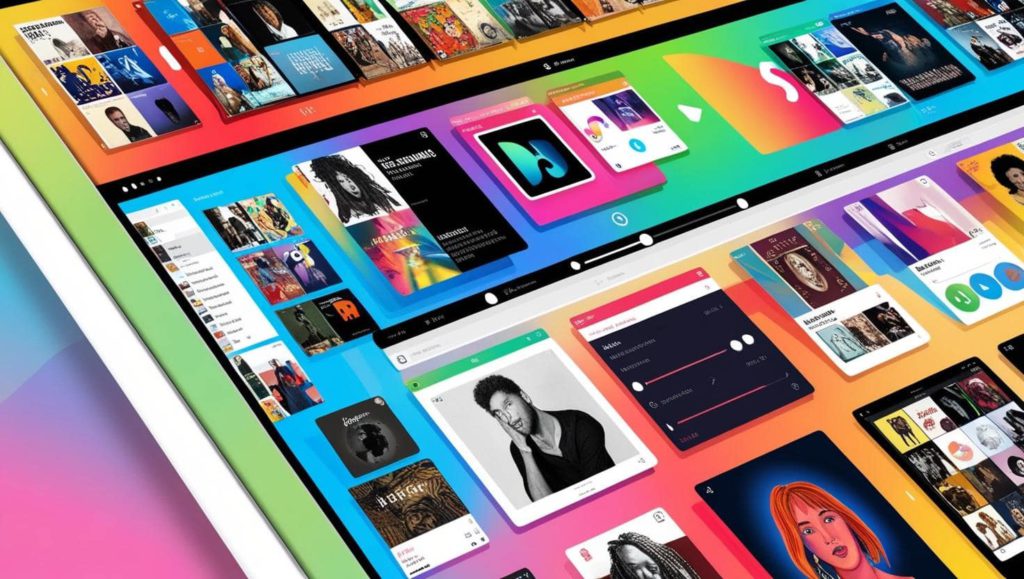So many streaming platforms, should you use them all? There could be no harm in doing so. However, can you successfully market each store independently?

In the ever-evolving digital music landscape, independent artists have more opportunities than ever to share their music with the world. With the rise of streaming platforms, artists can distribute their music globally, grow their fanbases, and generate income from their work.
However, not all streaming platforms are created equal. Especially when it comes to supporting independent musicians. In 2024, certain platforms offer unique features and benefits that can help indie artists thrive in a competitive industry. Here’s a look at some of the best streaming platforms for independent artists.
1. Spotify
Best for: Global reach and playlist placement
Spotify remains one of the most popular and widely used streaming platforms. Offering independent artists access to millions of listeners worldwide. With over 400 million active users, it’s a go-to platform for both mainstream and indie artists.
Key features for independent artists:
- Spotify for artists: A powerful tool that gives musicians detailed analytics on their streams, audience demographics, and playlist placements. Artists can also pitch their music to Spotify’s editorial playlists and engage with their fans directly.
- Playlist exposure: Getting placed on one of Spotify’s many curated playlists—whether editorial or user-generated—can dramatically increase an artist’s visibility.
- Spotify codes: Allows you to create scannable codes for your music. Helping promote your tracks both online and offline.
Challenges:
- While Spotify offers great exposure, their payment per stream can be lower compared to some other platforms. Especially for independent artists.
2. Apple Music
Best for: High-quality audio and loyal fanbase
Apple Music has become a strong contender in the streaming market. Boasting a huge user base and a focus on high-quality audio streaming. Independent artists benefit from the platform’s emphasis on curated playlists, radio shows, and a strong integration with other Apple products.
Key features for independent artists:
- Apple Music for artists: Provides detailed insights into streaming data, including how your music is performing and which regions are engaging with your content. Artists can also create custom playlists and share them with fans.
- Music distribution: Apple Music offers streamlined access for artists through distribution services like RouteNote, and others. This makes it easy for independent musicians to get their music on the platform without a label.
- Exclusive content: Apple Music has a history of partnering with artists to offer exclusive content, such as early album releases or special behind-the-scenes footage.
Challenges:
- Apple Music has a smaller user base compared to Spotify, but the platform’s dedicated, music-focused audience offers more engaged listeners.
3. YouTube Music
Best for: Visual content and monetisation opportunities
YouTube Music is a powerful platform for artists, especially those who already have a YouTube presence. With millions of active users and a built-in video element, YouTube Music is great for independent musicians looking to share not just their audio, but also their visual content.
Key features for independent artists:
- YouTube for artists: Provides analytics and insights into how your videos are performing on both YouTube and YouTube Music. Artists can also create custom channels to feature their music and videos.
- Monetisation: YouTube offers multiple monetisation options. Including ad revenue and super chats for live streams. Independent artists can generate income from their music videos, live performances, and even fan interactions.
- Video integration: Because YouTube Music is integrated with YouTube, artists can upload their music videos directly to the platform and gain exposure in both the music and video spheres.
Challenges:
- YouTube’s vast array of content can make it harder for new or independent artists to get noticed, as your music may get buried under an enormous volume of other videos.
4. Tidal
Best for: High-quality streaming and artist royalties
Tidal is a platform that places a strong emphasis on artist-friendly features. Including higher royalties and premium sound quality. For independent artists looking to optimise their revenue from streams, Tidal offers more favourable terms than many other services.
Key Features for independent artists:
- Tidal for artists: This platform provides comprehensive insights into streams, earnings, and audience demographics. Tidal also supports direct communication with fans and offers a unique “Tidal Rising” program to help emerging artists gain exposure.
- Higher royalties: Compared to other platforms, Tidal offers a more favourable payment structure for artists, making it appealing for independent musicians seeking fairer compensation.
- Hi-Fi audio quality: Tidal is known for offering high-fidelity audio, which can be a selling point for audiophile listeners and musicians who want to showcase their music in the highest quality possible.
Challenges:
- While Tidal’s payouts may be higher, the platform has a smaller user base than Spotify and Apple Music, meaning it might not be the best option for those solely seeking mass exposure.
5. Bandcamp
Best for: Direct artist-to-fan sales and niche markets
Bandcamp is a favourite among independent musicians because it allows them to sell their music directly to fans, keeping a much larger percentage of the revenue. Unlike other streaming platforms, Bandcamp emphasises artist control over pricing, sales, and marketing.
Key features for independent artists:
- Revenue control: Bandcamp gives artists the freedom to set their own prices and even offer pay-what-you-want options, allowing for more flexibility in how they generate income.
- Merchandising: Artists can also sell merchandise, vinyl, and other physical products directly to their audience. This creates an additional income stream beyond digital music sales.
- Fan engagement: Bandcamp provides tools for direct fan communication, enabling artists to build a community and foster deeper relationships with their listeners.
Challenges:
- While Bandcamp offers more revenue potential, it does not have the same global reach as Spotify or Apple Music, so it’s better suited for artists who already have a dedicated fanbase or a niche following.
6. SoundCloud
Best for: Music discovery and community engagement
SoundCloud is a platform that has long been a haven for independent artists, especially those looking to build a community and get discovered by new fans. The platform encourages emerging artists to upload their music and share it with a wide audience.
Key features for independent artists:
- SoundCloud Pro: Artists can use SoundCloud Pro to access detailed analytics, get more upload time, and enable monetisation features. Pro users can also control how their tracks are shared and distributed.
- Discoverability: SoundCloud is known for its organic music discovery system. Where listeners often find new artists through recommendations and reposts.
- Monetisation: Through SoundCloud’s Premier Program, independent artists can monetise their tracks, receive revenue from streams, and participate in the platform’s creator fund.
Challenges:
- SoundCloud’s reputation as a platform for emerging artists means it can be highly competitive, and standing out requires constant engagement with listeners and a strong social media presence.
7. Deezer
Best for: Global reach and indie music promotion
Deezer is another streaming platform with a strong global presence. While it might not have the same mass appeal as Spotify or Apple Music, Deezer offers a variety of tools to help independent artists grow their fanbase.
Key features for independent artists:
- Deezer for creators: Deezer offers analytics, promotional tools, and access to a global audience. It also provides tools for artists to connect directly with their fans and track their music’s performance.
- Promotions and support: Deezer supports indie artists through programs like Deezer Next, which helps emerging talent gain exposure and build their careers.
Challenges:
- Deezer has a smaller user base compared to the top platforms, but its global reach and niche focus on indie music give it a unique position for certain artists.
The best streaming platform for independent artists in 2024 depends on your specific needs and goals. Spotify and Apple Music offer the largest reach and are essential for global exposure. Tidal is a strong choice for artists looking for better royalty rates, while Bandcamp is perfect for those wanting more control over their sales and fan relationships.
SoundCloud and Deezer continue to serve as strong contenders for artists looking to engage with niche communities or build a grassroots fanbase. Ultimately, a combination of platforms may be the best strategy for independent artists—leveraging each service’s unique strengths to reach as many listeners as possible while maintaining control over their music and revenue.



